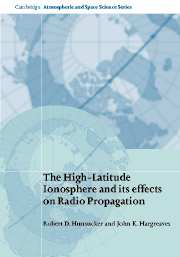Book contents
- Frontmatter
- Contents
- From the Times of London
- Preface
- Chapter 1 Basic principles of the ionosphere
- Chapter 2 Geophysical phenomena influencing the high-latitude ionosphere
- Chapter 3 Fundamentals of terrestrial radio propagation
- Chapter 4 Radio techniques for probing the ionosphere
- Chapter 5 The high-latitude F region and the trough
- Chapter 6 The aurora, the substorm, and the E region
- Chapter 7 The high-latitude D region
- Chapter 8 High-latitude radio propagation: part 1 – fundamentals and early results
- Chapter 9 High-latitude radio propagation: part 2 – modeling, prediction, and mitigation of problem
- Appendix: some books for general reading
- Index
Chapter 7 - The high-latitude D region
Published online by Cambridge University Press: 02 December 2009
- Frontmatter
- Contents
- From the Times of London
- Preface
- Chapter 1 Basic principles of the ionosphere
- Chapter 2 Geophysical phenomena influencing the high-latitude ionosphere
- Chapter 3 Fundamentals of terrestrial radio propagation
- Chapter 4 Radio techniques for probing the ionosphere
- Chapter 5 The high-latitude F region and the trough
- Chapter 6 The aurora, the substorm, and the E region
- Chapter 7 The high-latitude D region
- Chapter 8 High-latitude radio propagation: part 1 – fundamentals and early results
- Chapter 9 High-latitude radio propagation: part 2 – modeling, prediction, and mitigation of problem
- Appendix: some books for general reading
- Index
Summary
Introduction
The differences between the E and D regions in middle latitudes hold also at high latitude. The E region is characterized by relatively simple photochemistry and high electrical conductivity, whereas the D region below it has a complex and less well-known chemistry, the electric currents and plasma motions being inhibited by the higher atmospheric pressure. What they have in common at high latitude is the importance of ionization by energetic particles. Typical spectra include particles with energies such that they are stopped and ionize in both regions, the lower energies (for example, electrons of a few kilo-electron volts) affecting the E region and the higher ones (e.g. electrons with energies of tens of kilo-electron volts) penetrating into region D. Figure 7.1 shows electron-density profiles between 65 and 110 km due to representative spectra of ionizing electrons incident on the atmosphere from above. Increasing the characteristic energy of the spectrum lowers the peak of the layer, increasing the electron density in the D region but reducing it in the E region.
At middle latitude the D region's role in radio propagation is a secondary one. The main parameters of HF propagation are determined by the E and the F regions, and the D region acts mainly as an absorbing layer, reducing the strength of the signal but seldom preventing communications for any long period. At high latitude the D region may be much enhanced and then absorption becomes a considerable problem.
- Type
- Chapter
- Information
- Publisher: Cambridge University PressPrint publication year: 2002



